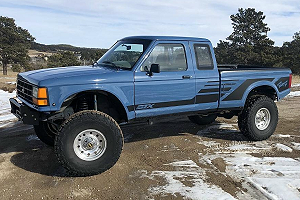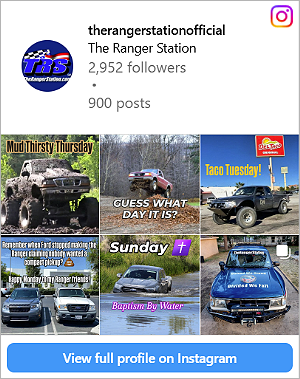- Joined
- Feb 22, 2011
- Messages
- 475
- Reaction score
- 19
- Location
- Mississippi
- Vehicle Year
- 1994
- Make / Model
- Mazda
- Engine Type
- 3.0 V6
- Engine Size
- 3.0
- Transmission
- Manual
- 2WD / 4WD
- 2WD
- Total Lift
- N/A
- Total Drop
- N/A
Original Poster: Daniel Inbinett (gungfudan)
Dificulty: 4 out of 10
The time depends on how experienced you are.
Disclaimer: The Ranger Station.com, The Ranger Station.com Staff, nor the original poster are responsible for you doing this modification to your vehicle. By doing this modification and following this how-to you, the installer, take full responsibility if anything is damaged or messed up. If you have questions, feel free to PM the original poster or ask in the appropriate section of The Ranger Station.com forums.
This is an explanation on how to trouble shoot you fuel level sending unit and what the ohms you need (depending on the year of you truck) for a new aftermarket fuel level gauge or to use a your factory gauge with a new fuel cell that has an after market sending unit. Note: the reason is if you do not have the correct ohm range your guage will not work.
Tools Needed:
an electricians meter (that reads ohms)
flat head screw dirver
Parts needed:
(All parts in list are based on if parts are bad or need repair.)
possibly new sending unit
auto wire
butt connectors
IMPORTANT!!!!!!!
Things you need to know before you start:
The fuel gauge is a fairly simple electronic. The fuel gage circuit consists of the sending unit in the fuel tank, the gauge in the dash, and the wiring and dash wiring (or circuit board) between them. It's power source comes from a voltage regulator that is 5 volts. (NEVER HOOK THE SENDING UNIT OR GAUGE TO A 12 VOLT BATTERY) Here is a picture of a sending unit on a 1988 Bronco II wiring diagram:
View attachment 8476
How It works:
The sending unit is a variable resistor. It resists the flow of current from the ground to the gauge depending on the position of the float within the tank. When the float arm is at the full position It decreases the resistance between gauge and ground.(basically there is shorter distance for the current to flow) The more current that flows through the meter, the higher the gauge needle moves.
The gauge uses a 5 volt pulse supplied by the instrument cluster's voltage regulator.
Troubleshooting:
Problem; The gauge does not work.(the needle does not move)
Turn the key to the on position for this operation. If you can get to your sending unit wiring harness without dropping your tank(s) go ahead and pull it. If not then drop the tank(s) and pull the harness. Get a piece of wire (jump wire) to connect to the possitive of the harness and the negative of the sender housing. This should make the gauge jump to full.
If the gauge's needle moves:
It means that the wiring is fine and it is your most likely your sending unit. You need to remove the sending unit from the tank for inspection and testing.
Here is a picture of a 1985-1988 sending unit.
View attachment 8474
The red arrow(the male connection), The black arrow (is the main part of the sender), The blue arrow (is the float that is attached to the sender arm).
After removing the sending unit inspect to make sure the float, float arm, wires, and the sender it self is intact and functioning properly. There is a possibility that the arm is binding so move it up and down to make sure. Hook up an ohm meter to it to check the ohms. To hook the owm meter to your sender follow the from the sender to the bottom of the plate and locate on the top which prong it is.(to see prongs go to picture below) now the groung is the one with no wire attached to it. Now move up to full and down to empty to check reading.
View attachment 8475
It should read depending on the year; pre-1989 empty 73 ohms/10 ohms full or 1989-on empty 16 ohms/158 ohms full. If it does not it could need repaired or replaced.
I have an 1988 Ford Ranger and my sending unit was not working. The guage worked so I knew there had to be something wrong withe the sended. Now if you have a mechanical fuel pump like mine then you can not get the sending unit for that year because they stoped making it for that year. Which to me was stupid it just is one metal tube on the sender plate and a two prong connection. So I had to get a sending unit for a 2.3L ranger and modify it. And it works great.
Back on topic.
If the gauge does not jump to full:
Ground the sending unit wiring to a good chassis ground (instead of the sending unit housing) and watch the gauge. Does it now jump to the 'Full' side?The power supply to the gauge has been interrupted, (check fuses), the gauge is defective, or the wire from the gauge to the sending unit is open or has a break in it.
To check the voltage regulator for proper funtion use a tester. Probe the connector with the tester, it should flash on and off.
Note: If you are installing an after market fuel gauge you need to make sure that the gauge is the same ohms as your sender. It will not work if they are not the same. The same goes for after market sending units that you might get with a fuel cell. Check your instructions or call manufacturer for information.
Manufacturer of Gauges:
Auto Meter (have fuel gauges for ford)
Equus (have fuel gauges for Ford)
Sunpro
there are many others.
I hope this was helpful
I want to thank http://www.fordification.com for the information I read about.
Dificulty: 4 out of 10
The time depends on how experienced you are.
Disclaimer: The Ranger Station.com, The Ranger Station.com Staff, nor the original poster are responsible for you doing this modification to your vehicle. By doing this modification and following this how-to you, the installer, take full responsibility if anything is damaged or messed up. If you have questions, feel free to PM the original poster or ask in the appropriate section of The Ranger Station.com forums.
This is an explanation on how to trouble shoot you fuel level sending unit and what the ohms you need (depending on the year of you truck) for a new aftermarket fuel level gauge or to use a your factory gauge with a new fuel cell that has an after market sending unit. Note: the reason is if you do not have the correct ohm range your guage will not work.
Tools Needed:
an electricians meter (that reads ohms)
flat head screw dirver
Parts needed:
(All parts in list are based on if parts are bad or need repair.)
possibly new sending unit
auto wire
butt connectors
IMPORTANT!!!!!!!
Things you need to know before you start:
The fuel gauge is a fairly simple electronic. The fuel gage circuit consists of the sending unit in the fuel tank, the gauge in the dash, and the wiring and dash wiring (or circuit board) between them. It's power source comes from a voltage regulator that is 5 volts. (NEVER HOOK THE SENDING UNIT OR GAUGE TO A 12 VOLT BATTERY) Here is a picture of a sending unit on a 1988 Bronco II wiring diagram:
View attachment 8476
How It works:
The sending unit is a variable resistor. It resists the flow of current from the ground to the gauge depending on the position of the float within the tank. When the float arm is at the full position It decreases the resistance between gauge and ground.(basically there is shorter distance for the current to flow) The more current that flows through the meter, the higher the gauge needle moves.
The gauge uses a 5 volt pulse supplied by the instrument cluster's voltage regulator.
Troubleshooting:
Problem; The gauge does not work.(the needle does not move)
Turn the key to the on position for this operation. If you can get to your sending unit wiring harness without dropping your tank(s) go ahead and pull it. If not then drop the tank(s) and pull the harness. Get a piece of wire (jump wire) to connect to the possitive of the harness and the negative of the sender housing. This should make the gauge jump to full.
If the gauge's needle moves:
It means that the wiring is fine and it is your most likely your sending unit. You need to remove the sending unit from the tank for inspection and testing.
Here is a picture of a 1985-1988 sending unit.
View attachment 8474
The red arrow(the male connection), The black arrow (is the main part of the sender), The blue arrow (is the float that is attached to the sender arm).
After removing the sending unit inspect to make sure the float, float arm, wires, and the sender it self is intact and functioning properly. There is a possibility that the arm is binding so move it up and down to make sure. Hook up an ohm meter to it to check the ohms. To hook the owm meter to your sender follow the from the sender to the bottom of the plate and locate on the top which prong it is.(to see prongs go to picture below) now the groung is the one with no wire attached to it. Now move up to full and down to empty to check reading.
View attachment 8475
It should read depending on the year; pre-1989 empty 73 ohms/10 ohms full or 1989-on empty 16 ohms/158 ohms full. If it does not it could need repaired or replaced.
I have an 1988 Ford Ranger and my sending unit was not working. The guage worked so I knew there had to be something wrong withe the sended. Now if you have a mechanical fuel pump like mine then you can not get the sending unit for that year because they stoped making it for that year. Which to me was stupid it just is one metal tube on the sender plate and a two prong connection. So I had to get a sending unit for a 2.3L ranger and modify it. And it works great.
Back on topic.
If the gauge does not jump to full:
Ground the sending unit wiring to a good chassis ground (instead of the sending unit housing) and watch the gauge. Does it now jump to the 'Full' side?The power supply to the gauge has been interrupted, (check fuses), the gauge is defective, or the wire from the gauge to the sending unit is open or has a break in it.
To check the voltage regulator for proper funtion use a tester. Probe the connector with the tester, it should flash on and off.
Note: If you are installing an after market fuel gauge you need to make sure that the gauge is the same ohms as your sender. It will not work if they are not the same. The same goes for after market sending units that you might get with a fuel cell. Check your instructions or call manufacturer for information.
Manufacturer of Gauges:
Auto Meter (have fuel gauges for ford)
Equus (have fuel gauges for Ford)
Sunpro
there are many others.
I hope this was helpful
I want to thank http://www.fordification.com for the information I read about.














